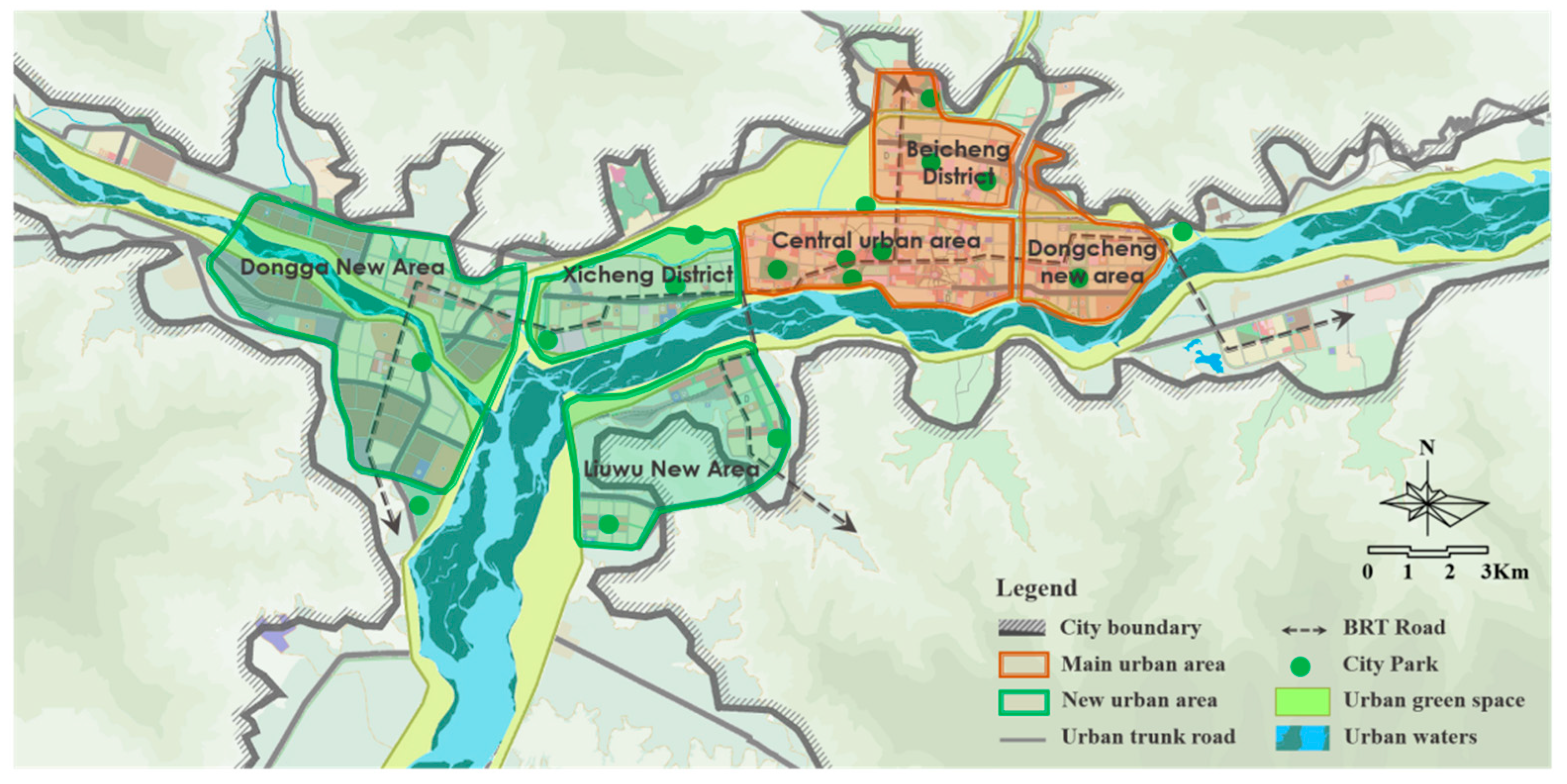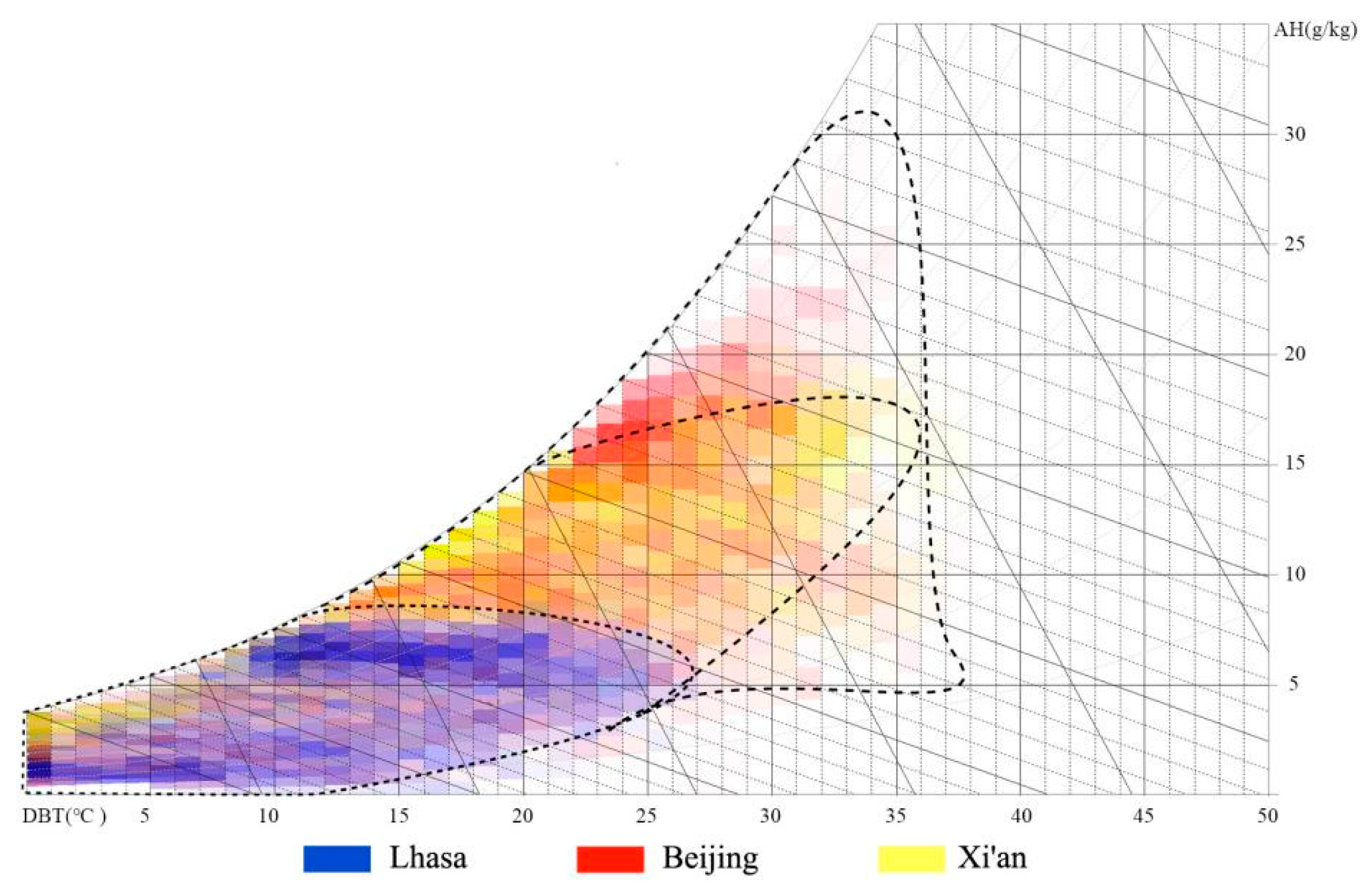Landscape elements have a direct impact on the thermal environment and have become an important means to improve the quality of life of residents. However, the selection and configuration of landscape elements have different effects on human thermal comfort under different climatic conditions. Lhasa is located in the middle of the Qinghai Tibet Plateau, with an altitude of 3650 meters. Due to the particularity of its geographical location, the climate conditions in Lhasa are significantly different from those in Beijing, Xi'an, Lanzhou and other cities in the same climate area. At the same time, the local residents are mainly Tibetans. Religious culture and climate conditions have led to significant differences in the living habits and the needs for thermal comfort of local residents compared with those of residents in other cities. Therefore, researcher focuses on special climatic conditions, taking the typical residential areas in Lhasa, Tibet as the research object, in order to better understand the impact of residential landscape elements on the outdoor thermal environment and thermal comfort in the plateau cold climate area.
- high altitude
- landscape elements
- outdoor thermal comfort
- orthogonal experiment
1. Unique Geographical Location and Climatic Conditions of Lhasa
Lhasa is located in the middle of the Qinghai Tibet Plateau, with an altitude of 3650 meters. The plane of the city of Lhasa is distributed in a belt from east to west. Two mountains (South Mountain and North Mountain of Lhasa) sandwich the city, and a river (Lhasa River) passes through the city. It is a typical axial development city, as shown in Figure 1. According to the Chinese standard meteorological data, the hottest month is June, and the coldest month is January. The monthly average maximum temperature is above 20°C, the monthly average minimum temperature is below −3°C, and the annual temperature difference is 18.1°C . Lhasa belongs to the cold region in China's architectural climate zoning, but because it is located in the Qinghai Tibet Plateau, the climate conditions of Lhasa are significantly different from those of Beijing, Xi'an, Lanzhou (cold climate region), and other cities. By comparing the enthalpy and humidity diagrams of the three cities (Figure 2), it can be seen that the annual temperature and the humidity of Lhasa are relatively lower, and the annual temperature difference is also relatively smaller. Beijing and Xi'an also have coexisting heat and humidity, but Lhasa has a dry climate, so there is no such phenomenon.

Figure 1. City map of Lhasa.

Figure 2. Enthalpy humidity diagram and solar radiation intensity comparison diagram of Lhasa, Beijing, and Xi’an.
2. Characteristics of Residents' Behavior Habits
The Lhasa area is affected by strong radiation, and the demand for shade space in summer is greater than that in winter. There is also a greater objective demand for the comfort of the outdoor space thermal environment in summer and winter (Figure 3). Through a questionnaire survey, researchers examined the behavioral characteristics of outdoor activities of the local residents in Lhasa. The content of the questionnaire mainly included two parts: (1) basic information about respondents (gender, age, name, and ethnicity); and (2) respondents' behavior habits (activity time, activity form, and preferred activity venue).
3. Research Status of the Impact of Landscape Elements on Outdoor Thermal Comfort under Different Climatic Conditions
Determining how to create a healthy outdoor thermal environment based on nature based solutions has become a hot research topic, and it is particularly important to improve the outdoor thermal environment in residential areas because they are the basis for many outdoor activities. The landscape environmental factors that are closely related to the outdoor thermal environment and thermal comfort of a residential area mainly include greening, water bodies, and underlying surface. In terms of greening, in hot and arid areas, choosing trees that can reduce solar radiation is the most effective urban design strategy for reducing physiological equivalent temperature (PET) . The research of Middel et al. proved that compact building layouts had a greater impact on air temperature during the day than greening, the use of trees in compact low-density building areas reduced the temperature by 2 ◦C, and trees in high-density building areas could effectively reduce air temperature by 0.2–0.4 ◦C , but this was ineffective in Cairo’s low-density built-up areas . In hot and humid climates, studies by Srivanit et al. and Zhuang et al. confifirmed that trees could affect solar radiation and change the wind environment, signifificantly reducing the average radiation temperature (Tmrt) and PET. The structure of the canopy, as well as the size, shape, and color of the leaves, affected the level of solar radiation . In cold climates, in addition to improving the outdoor thermal environment in summer , trees can also effectively improve the outdoor wind environment in winter by adjusting the layout of trees . In temperate climates, Lee et al. confifirmed that the combined form of trees and lawns had a more signifificant effect on Tmrt and PET than lawns alone. In terms of water bodies, Lu et al. used a humid and hot climate as the background to confifirm that a water body had a cooling effect in the daytime warming stage. Additionally, the evening cooling stage played a role in heat preservation and had the effect of humidifying and regulating the wind speed. In cold climatic conditions, the scale of inflfluence of hot and humid environments in waterfront residential areas depends largely on the volume ratio, the height of the embankment, and the greening . In addition, the characteristics of the ground are an important factor that affect the thermal comfort of residents . In a humid and hot climate, the research of Kwan et al. ,Guo et al. , and Song et al. found that the temperature of an impermeable surface was higher than the temperature of a permeable surface, and a natural lower pad surface had a better cooling effect. In mild climates, Santamouris et al. showed that materials with high reflflectivity could signifificantly affect the thermal comfort of the human body, but the study of Taleghani et al. showed that both the Tmrt and PET increased with increasing reflflectivity. Researchers found that the impact of landscape elements on the regional thermal environment in different climatic zones has been studied many times before, and that their research results were also different from each other, but studies of the synergy mechanism between various landscape elements are still relatively lacking. Each city is in a specifific regional atmospheric environment, and the differences in urban climate affect the mechanism of improvement of landscape elements for the outdoor thermal environment. China’s Tibet region is affected by its special geographical location, climatic conditions, and religious culture. The impact of landscape elements on the thermal environment is different from those of other climatic zones. Local residents carry out a large number of outdoor activities every day, and frequent and long-term outdoor activities put forward higher requirements for the outdoor environment. However, there are relatively few studies on high-altitude cold climate zones, and it is diffificult to provide theoretical support for improving the quality of the living environment in extremely cold climates.
Therefore, in order to better understand the impact of residential landscape elements on the outdoor thermal environment and thermal comfort in a high-altitude cold climate area, taking Lhasa as an example, the thermal environment of a residential area with different landscape element confifigurations was numerically simulated based on the orthogonal experimental design method. The PET was taken as the optimization objective, and the simulation results were analyzed with intuitive analysis and variance analysis.
This entry is adapted from the peer-reviewed paper 10.3390/ijerph19106303
References
- Colter, K.R.; Middel, A.C.; Martin, C.A. Effects of Natural and Artificial Shade on Human Thermal Comfort in Residential Neighborelative Humidityood Parks of Phoenix. Urban For. Urban Green. Ariz. 2019, 44, 126429. [CrossRef]
- Middel, A.; Häb, K.; Brazel, A.J.; Martin, C.A.; Guhathakurta, S. Impact of urban form and design on mid-afternoon microclimate in Phoenix Local Climate Zones. Landsc. Urban Plan. 2014, 12, 16–28. [CrossRef]
- Abaas, Z.R. Impact of development on Baghdad’s urban microclimate and human thermal comfort. Alex. Eng. 2020, 59, 275–290. [CrossRef]
- Aboelata, A.; Sodoudi, S. Evaluating the effect of trees on UHI mitigation and reduction of energy usage in different built up areas in cairo. Build. Environ. 2020, 168, 106490. [CrossRef]
- Srivanit, M.; Srivanit, D. Modeling the influences of layouts of residential townhouses and tree-planting patterns on outdoor thermal comfort in Bangkok suburb. J. Build. Eng. 2020, 30, 101262. [CrossRef]
- Zhuang, L.; Cai, Y.; Qi, J. Thermal environment simulation and thermal comfort analysis of Fuzhou University Campus in winter based on ENVI-met. J. Meteorol. Environ. 2021, 37, 9.
- De Abreu-Harbich, L.V.; Labaki, L.C.; Matzarakis, A. Effect of tree planting design and tree species on human thermal comfort in the tropics Landsc. Urban Plan. 2015, 138, 99–109. [CrossRef]
- Yang, Y.; Zhou, D.; Wang, Y.; Meng, X.; Gu, Z.; Xu, D.; Han, X. Planning method of centralized greening in high-rise residential blocks based on improvement of thermal comfort in summer. Sustain. Cities Soc. 2022, 80, 103802. [CrossRef]
- Hong, B.; Lin, B. Numerical studies of the outdoor wind environment and thermal comfort at pedestrian level in housing blocks with different building layout patterns and trees arrangement. Renew. Energy 2015, 73, 18–27. [CrossRef]
- Lee, H.; Mayer, H.; Chen, L. Contribution of trees and grasslands to the mitigation of human heat stress in a residential district of Freiburg, Southwest Germany. Landsc. Urban Plan. 2016, 148, 37–50. [CrossRef]
- Lu, W.; Wang, X.; Zhou, H. Numerical simulation of local climate regulation of water body in residential area. Archit. Sci. 2015, 31, 7.
- Song, X.; Liu, J.; Yu, L. Analysis on the influence of waterfront residential area design on summer thermal and humid environment in northern China. Archit. Sci. 2015, 31, 6.
- Lu, J.; Zhang, M.; Pei, W. Hydro-thermal Behaviors of the Ground under Different Surfaces in the Qinghai-Tibet Plateau. Cold Reg. Sci. Technol. 2019, 161, 99–106. [CrossRef]
- Kwan, C.P.; Jim, C.Y. Subjective outdoor thermal comfort and urban green space usage in humid-subtropical Hong Kong. Energy Build. 2018, 173, 150–162.
- Guo, Q.; Zou, Z.; Li, H. Thermal environment characteristics and heat is land intensity of villages in Shenzhen City. Ecol. Environ. 2015, 3, 67–75.
- Santamouris, M.; Gaitani, N.; Spanou, A.; Saliari, M.; Giannopoulou, K.; Vasilakopoulou, K. Using cool paving materials to improve microclimate of urban areasedesign realization and results of the flisvos project. Build. Environ. 2012, 53, 128–136. [CrossRef]
- Taleghani, M. The impact of increasing urban surface albedo on outdoor summer thermal comfort within a university campus. Urban Clim. 2018, 24, 175–184. [CrossRef]
